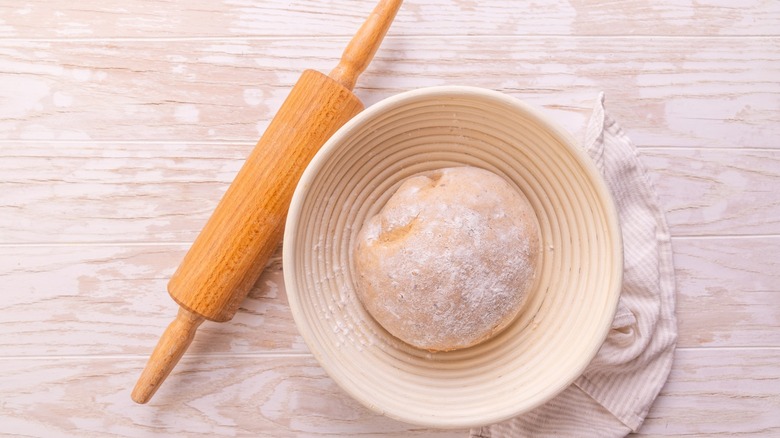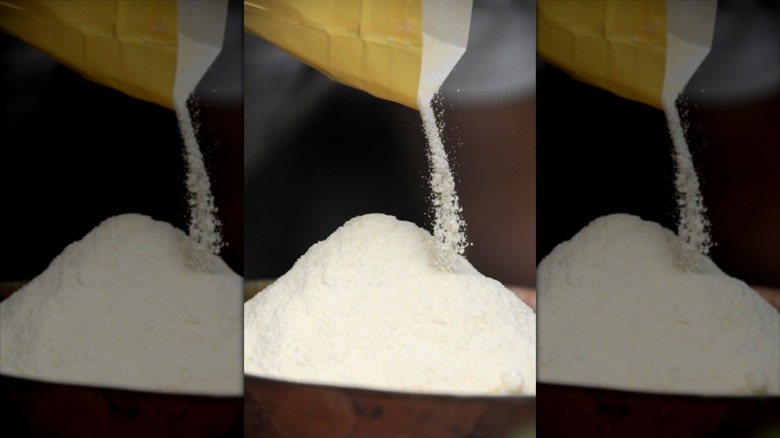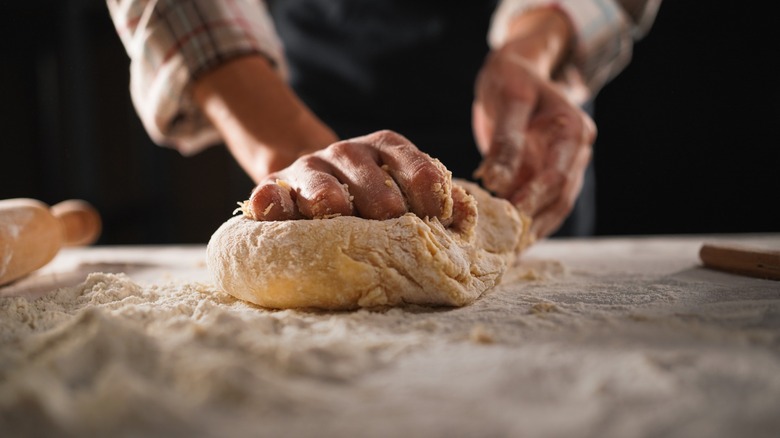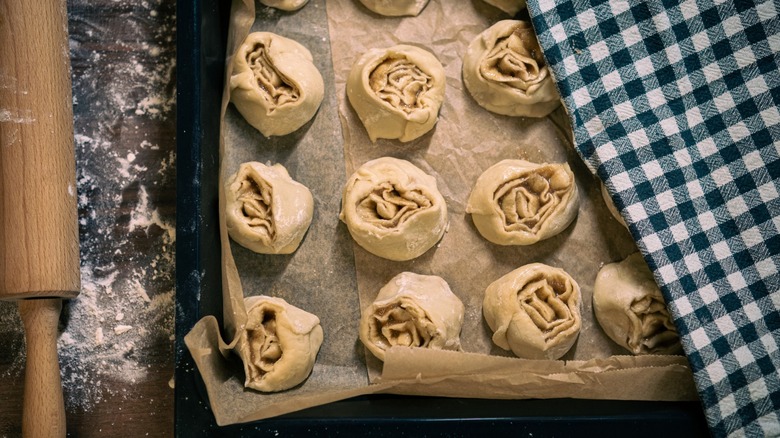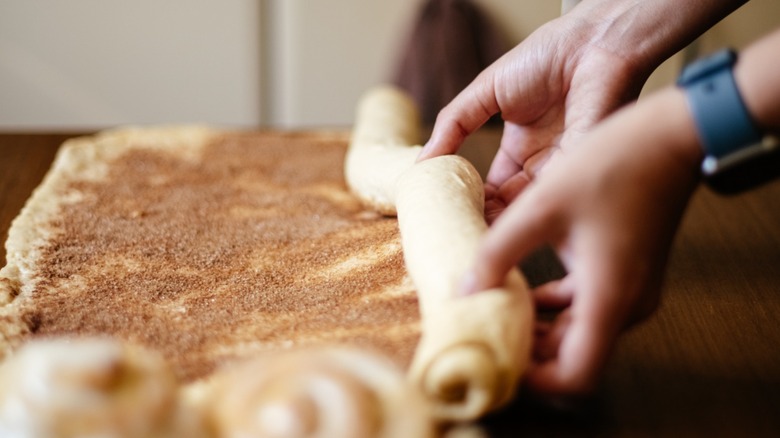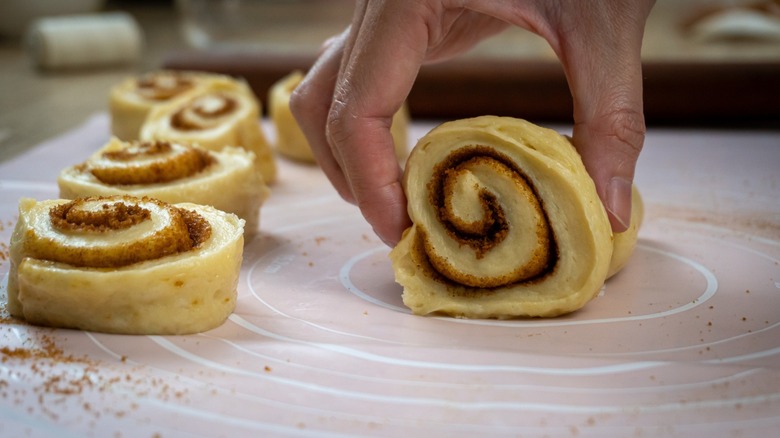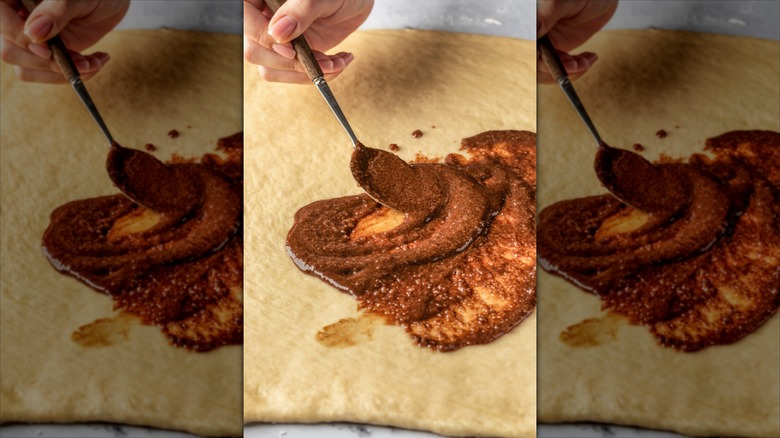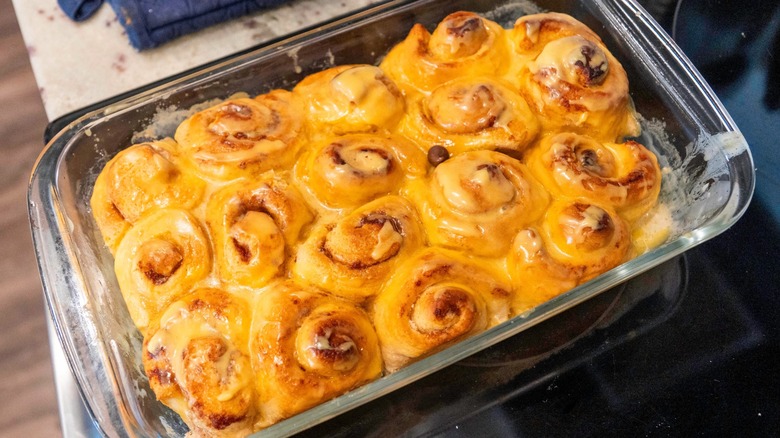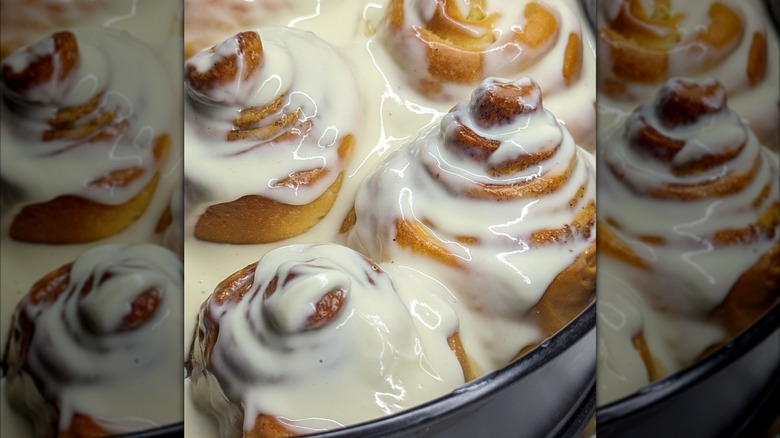11 Mistakes You Are Making With Homemade Cinnamon Rolls
You've finally cleared your schedule, tied that apron around your waist, and announced optimistically to the universe, "Today, I make homemade cinnamon rolls!" You already deserve a trophy. A little advice? You may want to add a crash helmet to your baking attire, because diving into from-scratch cinnamon rolls is a battlefield of butter and a roller coaster of emotions. It's not for the faint of heart. Just like any battle, glory awaits those who prevail, but to do so, you must bypass approximately one bazillion ways to accidentally sabotage yourself.
You'll find yourself facing the dough that mysteriously refuses to rise, the filling that somehow shrinks in volume like Alice in Wonderland taking a bite of the "Eat Me" candy, and those tear-inducing moments when your cinnamon roll spirals look less like bakery perfection and more like sad little pastry snails. Embarking on this journey is a commitment that will test your patience. But breathe deep. You're in the right place. To guide us through the minefield, we enlisted expert and true dough whisperer Amy Lund.
Amy is the baker extraordinaire behind the aptly named Dough Lady, a bakery built entirely on crafting some of the best cinnamon rolls in the U.S. This Dough Lady knows her stuff, as her TikTok page shows, so we're stepping aside and letting her school us. Here are the 11 mistakes you're making with homemade cinnamon rolls, and how to dodge every last one like the pastry-savvy champion you are — or will be, by gosh!
1. Killing the yeast with hot liquid
There comes a moment in every cinnamon-roll journey where you stand at the stove, holding a pot of warm liquid, ready to introduce your yeast to its new home. And fam, it feels fragile. There are some common beginner mistakes baking with yeast, and this is where one of them often occurs. The goal is to get, and keep, your roll dough warm and cozy, not scorch it within an inch of its life. That may sound dramatic, but any extreme in temperature really is a matter of life and death for your dough. Too hot, and your yeast comes to a tragic end. Too cold, and it sits there refusing to do anything, like a moody housecat.
This is why many bakers rely on thermometers instead of vibes. Amy Lund stresses (kindly) that this stage determines whether you're making cinnamon rolls or cinnamon regrets. As she puts it, "This is a make-or-break moment in your dough process. Yeast thrives between 95–105°F, so we use a thermometer to check our milk temperature for every single batch. If your liquids are too hot, the yeast dies — and all your work goes to waste."
So before you heat your liquids, slow down. Resist the insane urge to crank the dial to dragon breath mode, let the milk warm gently, and check the temperature. Your dough will thank you later when it rises like a champ.
2. Using expired yeast
Few things obliterate a baker's enthusiasm like discovering halfway through a recipe that the yeast they confidently grabbed from the pantry expired during a presidential election ... several presidents ago. If you find yourself in this situation, you may wonder whether it's possible to bake with expired yeast. Well, yeast may be tiny, but it has big responsibilities, and it simply cannot be expected to perform miracles when it's past its prime. Cinnamon rolls rely on active yeast, as the kind of "dough-getter" that's perky and puffs up. That's why proofing yeast before committing it to the full dough is advised.
Proofing is basically a wellness check for your soon-to-be bread. Once you've checked in, mix the yeast with warm water and a little sugar, and wait to see if it responds like a leapfrog, or more like a slug. Amy Lund explains, "If you're using active dry yeast, a little sugar helps wake it up! We sprinkle some over the top to activate it. You'll know your yeast is alive when it puffs up in the liquid."
Sadly, if your yeast doesn't puff, then it's likely expired for good. There's no room for sentimentality or emotional attachment here. If you feel guilty for tossing less-than-lively yeast out, just remember that old yeast will betray you with dense, flat rolls that taste like failure. Fresh yeast, on the other hand, delivers the fluffy, cloud-like dreams every cinnamon roll aspires to be.
3. Adding too much flour
One common pitfall for home bakers is not quite knowing how to measure flour for baking. Flour is sneaky and temperamental. Over-flouring is one of the biggest cinnamon-roll sabotages. You try not to feel the pressure as you tell yourself, "just a little more," then suddenly, it all becomes too much (literally). The dough is stiff, dry, and has clearly betrayed you.
The problem often starts with how flour is measured. Scooping directly into the flour bag packs the flour tighter than your skinny pants feel following Thanksgiving turkey, and that "extra weight" leads to tough dough. Cinnamon roll dough should be soft, slightly sticky, and almost clingy. Too much flour ruins that delicate chemistry. You could confidently say Amy Lund is a major advocate for weighing ingredients, insisting that "Weighing your dry ingredients will actually change your life. You want a dough you can handle without it sticking all over your hands, but adding too much flour will totally change your texture — and not in a good way."
That's why professional bakers lean on kitchen scales instead of guesswork. So instead of shoveling flour into your measuring cup, get dainty with it, spooning it lightly or switching to weighing. Let the dough be a little soft, a little sticky, a little alive. Embrace that mild chaos. And remember, cinnamon rolls are forgiving, but only when we stop trying to turn them into stiff little rock-hard dinner rolls, fam.
4. Overworking the dough
We have a running joke regarding the near healing qualities of being in the kitchen: "Feel Like Punching A Wall This Week? Try Baking Instead!" It may be funny, but there really is something oddly therapeutic about kneading dough in particular. Unfortunately, our enthusiasm for it can quickly turn into over-kneading, and that's one recipe that can only lead to ruin.
Cinnamon roll dough is tender by nature, and overworking it creates tight gluten networks that bake up tough and chewy, which is the exact opposite of the soft, pillowy experience we're all aiming for. The trick is stopping at the right moment. But how do you know? Amy Lund teaches her bakers a really smart method of measuring. She advises, "Use the windowpane test to see if your gluten is fully developed. Pinch off a small piece of dough and gently stretch it between your fingers. If it pulls into a thin, almost see-through sheet — like a cute little window — without tearing, your dough is ready to go! If it rips right away, it just needs a bit more kneading."
Simple. Straightforward. Once it passes the windowpane test? Step away, fam. Resist that urge to "just give it a few more kneads." Nobody needs that.
5. Under-proofing or over-proofing the dough
Proofing dough is where cinnamon rolls either literally rise to the occasion or fall short. Too little time, and the dough stays dense and heavy. Too much time, and it collapses like a bad pastry Ponzi scheme. What makes proofing tricky is that it's not about time, but more about watching and being able to read the dough. Here is where we have to remember that recipes give guidelines, not guarantees. Much of this is because every kitchen is its own unique environment, and that can affect what comes out of the oven. As Amy Lund explains, "A warm kitchen will speed things up, and a colder one will slow everything down. All of that to say, proofing can be mysteriously unpredictable — and hence, maddening!
Lund feels strongly about the importance of properly proofing. "Proofing is one of the most important steps in a cinnamon roll. I always tell people to watch the dough, not the clock. You're looking for it to visibly double in size during both the first and second rise." The trick, she explains, is not to just watch the clock. "Trust the dough's appearance and feel more than any set timeline."
Think of proofing like getting ready for a special event, where some people need just a few minutes, and others need hours. You do not know how diva your dough is gonna be each time, so don't ruin the entire date by getting impatient, fam!
6. Not rolling the dough tightly enough
Rolling cinnamon-roll dough is one of those delicate tasks where overconfidence can betray you. Get too loose with it, and, once placed in the oven, your rolls will unravel like a teenage girl at her first boy band concert. But not so fast. If you veer too far to the other end of the enthusiasm spectrum, rolling too tight, the rolls will expand upward into strange, misshapen monstrosities that look more like Halloween witch hats than heavenly baked goods.
The goal for your roll is to achieve a snug, consistent spiral, like the perfect swirl you see in professional bakery windows. Amy Lund explains the balance perfectly, saying, "If you roll the dough too tight, the spiral expands too much and bakes into a cone. But if it's too loose, the filling spills right out — which is very, very sad to pull out of the oven. Aim for a snug, even spiral." When rolling, think of it as guiding the dough rather than forcing it. Gentleness wins here. Once it's rolled, take a moment to admire your spiral of potential success.
7. Failing to seal the seam
There's nothing more heartbreaking than pulling a tray of cinnamon rolls out of the oven only to find that half of them look like they aborted their mission halfway through the baking cycle. How to avoid making cinnamon rolls feel like Mission Impossible? Nine times out of ten, the culprit is the seam (the edge of the dough that needs to be pinched shut after rolling). Leaving this part of the roll unsealed is basically inviting your rolls to unroll themselves, like a dramatic red carpet being unfurled with great pomp in front of a VIP. This is one proverbial red carpet we don't want, and since sealing the seam only takes a few seconds (yet makes a world of difference), just take a moment to pinch it.
Amy Lund points out that another factor many home bakers overlook is the pan they choose. She explains, "Pan choice matters here, too. You want the rolls to have enough room to expand, but not so much space that they can unravel. A snug fit helps the rolls support each other and keeps the filling inside. I never bake cinnamon rolls on a shallow sheet pan — a pan with 2–3-inch sides gives the best structure and rise." So think of sealing the seam and choosing the right pan as providing both emotional support and boundaries for your rolls. We could all use a bit more of that, and not just in the kitchen!
8. Not using enough filling
There's a universal sin committed daily in the baking world, and we find it unforgivable, fam. It happens when biting into a cinnamon roll, only to find a barely-there, sad little smear of cinnamon sugar hiding inside. It's right there in the name — there should be cinnamon! And lots of it! It's enough to get any pastry lover hot under the collar, and for those who say don't take it personally? Skimping on the cinnamon filling is not only a faux pas, it's a full-on baking betrayal.
To say we're big mad over this whole flimsy filling issue would be accurate, but we're not alone! Amy Lund also does not mince words about this pastry travesty. "My beef with cinnamon rolls is there's never enough filling so then it lacks flavor!" she says. "We always use the phrase 'more is more' in our kitchen. The more you add, the better the roll will be." More (and more) filling? Sign us up. It's a simple philosophy, and one worth adopting immediately. Filling kind of reminds us of the plot in a movie. Without enough of it, the whole experience is missing something, and you certainly aren't going to give it a stellar review.
9. Baking at the wrong temperature or overbaking
Just like moody teenagers, or the adorable kiddos going through year two, ovens can be unpredictable. They each have unique quirks, moods, and hot spots. Their behavior can be erratic, even, and make absolutely no sense (again, the similarities are uncanny). But back to the pastry ... Baking cinnamon rolls at the wrong temperature, or baking them for too long, can turn a promising tray of dough into either undercooked globs with gooey centers (and not the good kind) or dry rolls that practically crumble into dust. It can all be quite confusing — like, what even qualifies as room temperature when baking, really?
Amy Lund offers a practical, bakery-tested approach. "Every oven bakes differently, and almost all of them have a hot spot," she says. "Check your rolls halfway through and rotate the pan if you notice uneven browning. If the tops are getting too dark, tent the pan with foil and keep baking. If you know your oven runs hot, reduce the temperature by 25 degrees." Lund's advice for checking when the rolls are done is to look and see for yourself. "I always check the center where the rolls touch — if the dough feels set, they're done!"
Baking cinnamon rolls is a little like hosting a dinner party. You can't just ghost your guests and disappear for 20 minutes, leaving the guests hanging. The guests might mutiny, and will certainly make their ire known. So, too, will your rolls. So let's not burn any social bridges or cinnamon roll edges.
10. Packing the rolls too tightly in the pan
Just like us emotionally sensitive humans, cinnamon rolls need room to live their best lives. No one appreciates being crowded or having their personal space bubble invaded, right? When you pack your cinnamon rolls too tightly in the pan, they're unable to expand during their final rise, which means you end up with rolls that puff upward but not outward, which then leads to oddly shaped spirals with cramped edges. Not only does this make your rolls look wonky, but they can't feel great either. We'd imagine that what's a dang near claustrophobic experience for the dough will surely become a disappointing one for the baker.
Also like us emotional humans, on the flip side, giving the rolls too much space is not an environment they thrive in either! In the rolls' case, it makes them spread outward and flatten. Amy Lund emphasizes that the key is balance, explaining that, "If you pack the rolls too tight, they don't have room to puff up and expand. Give them some breathing space so they can rise properly." We like to think of this delicate pastry dance like arranging seats at a dinner party. Too close, and everyone gets bothered and bumps elbows. Too far, and the entire party vibe falls apart.
11. Frosting the rolls while too hot
We get it, fam. That moment when the smell of fresh cinnamon rolls coming out of the oven nearly makes you lose all rational thought. You want to frost them immediately, because of course you do. But frosting rolls while they're still blazing hot turns what should be a beautiful, thick, creamy topping into a thin and melty, sad little drizzle that slides when it should be sittin' pretty. Delicious? Sure. Sittin' pretty? Not even a little bit.
Just like us after the gym, cinnamon rolls need a short rest after cooking! Amy Lund explains, "Rolls need a few minutes to set when they come out of the oven — they're still baking a bit. I know it's hard to wait, but those extra ten minutes make a big difference! And the presentation will look so much better." Here's your chance to exercise self-restraint (we believe in you). By the time the rolls have cooled slightly, the frosting will glide on luxuriously, staying thick and creamy, and coating the spirals just right. Your patience will have paid off, and your reward will be sweet indeed.

